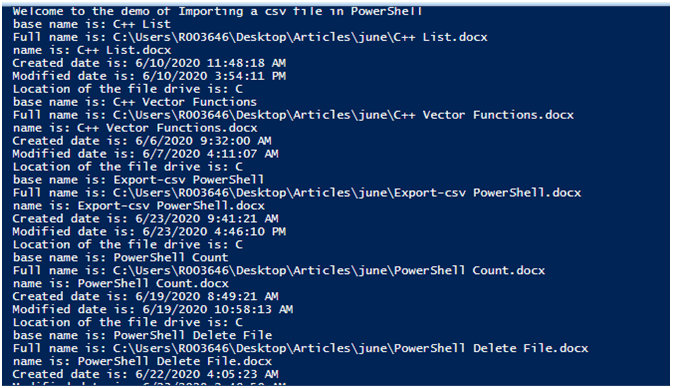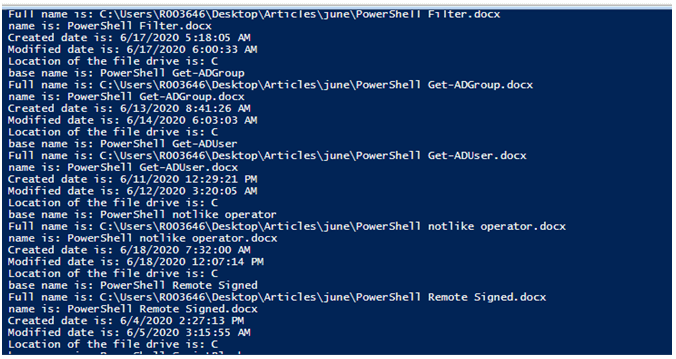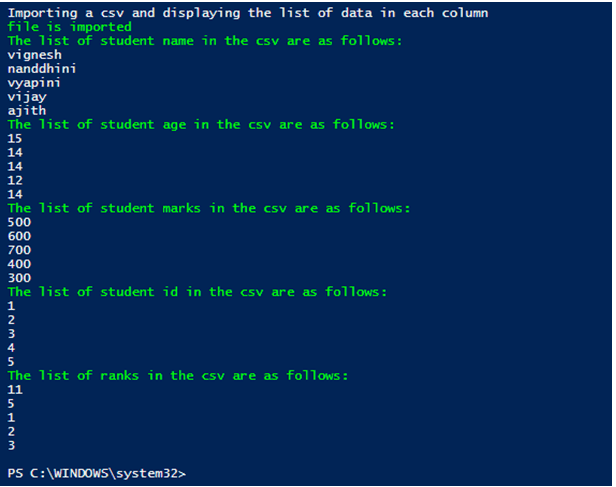How Are You Upload Cvs File to Draftkings

Introduction to PowerShell Import-CSV
The import-csv cmdlet is used to fetch the information contained in a comma separated file and create a table similar structure. One time the data is imported, then a foreach cmdlet is used to iterate the contents of the csv in a row wise manner. It is not necessary to import all the contents of the file, information technology is possible to apply filter conditions and fetch just the values that are required. This article will cover in particular on how to import a csv in powershell, sorting and filtering a csv file and the different means in which it can be achieved.
Syntax and Parameters
Syntax and parameters of powershell import-csv are given beneath:
Syntax:
Import-Csv [[-Delimiter] <Char>] [-Path] <String[]> [-Header <String[]>] [-Encoding <Encoding>] [<CommonParameters>] Import-Csv [[-Delimiter] <Char> -LiteralPath <String[]> [-Header <Cord[]>] [-Encoding <Encoding>] [<CommonParameters>]
Once the csv file is imported, each column in the csv file is considered as an object belongings and each row values corresponds to the property's values.
Parameters:
- -Delimiter: It denotes the marking or character which will be used for separating the values in the csv file. For a csv file, the default value of the delimiter is a comma (","). Other values such as a colon (":") or a semi-colon (";") tin also exist used. If the provided delimiter doesn't match with the delimiter that is present in the file, then the values will not exist imported, and respective objects won't be created. This parameter is of the char information type. Both pipeline input and wild card characters are not permitted by this parameter.
- -Encoding: This signifies the encoding musical instrument to be utilized for the specified csv file.The data sort of this parameter is encoding. The parameter doesn't recognize pipeline input and besides wild card characters are non permitted. The default sort of encoding utilized is UTF8NoBOM. The other adequate values are as follows.
- Bigendianunicodes
- Oem
- utf8BOM
- utf8NoBOM
- utf7
- utf8
- utf32
- ASCII
- -Header: Indicates an interchange column header push for the imported tape. This decides the objects backdrop names. The headers are to exist mentioned in a comma separated format. These shouldn't be enclosed within quotes . Encase each column header in single citation marks. If the entered header count is less than what it is available in the csv, then the remaining columns in the csv are discarded. If the entered value is greater than what information technology is bachelor in csv, the mentioned extra columns are added with null values. When utilizing the Header parameter, erase the initial header push from the CSV record. Something else, Import-Csv creates an additional question from the things within the header push. The information sort of this parameter is String[]. The default value is none. The parameter doesn't recognize pipeline input and too wild card characters are not permitted.
- -LiteralPath: This denotes the path where the csv file to exist imported is present. This can't exist anything typed dissimilar from its original value. No amending is allowed. Information technology has two aliases, PSPath and LP. The default esteem is none. It tin accept pipeline input whereas wild card characters are not permitted.
- -UseCulture: This denotes that the electric current culture is to be used every bit the item delimiter. The information sort of this parameter is Switch. The default esteem is none. Pipeline input is non accepted and wild menu characters are also non permitted.
Examples of PowerShell Import-CSV
Following are the examples are given beneath:
Example #one
Input:
Write-Host "Welcome to the demo of Importing a csv file in PowerShell"
$file= Import-Csv -Path "C:\test.csv"
$i=0
foreach ($f in $file)
{
if ($i -lt 10)
{
Write-Host "base of operations name is:" $f.BaseName
Write-Host "Total name is:" $f.FullName
Write-Host "name is:" $f.Proper noun
Write-Host "Created appointment is:" $f.CreationTime
Write-Host "Modified date is:" $f.LastAccessTime
Write-Host "Location of the file drive is:" $f.PSDrive
$i+=$i
}
}
Output:


In the above case, file the csv file is imported and stored in the file variable. Then each row of the csv file is looped. $f denotes the current row of the csv that is being accessed and to access the corresponding row values $f. corresponding header or column is used.
Case #2
Input:
Write-Host "example of reading a csv completely merely displaying result based merely on the users input"
$studentid= Read-Host "Enter the student roll no to fetch the educatee details"
Write-Host "Importing the csv file"
$file= Import-Csv -Path "C:\Users\R003646\Desktop\Articles\June\Educatee.csv"
Write-Host "File is imported successfully"
foreach ($row in $file)
{
if ($row.Sid -contains $studentid)
{
Write-Host "the mentioned student id is valid and his details are as follows" -ForegroundColor Green
Write-Host "Pupil name is:" $row.Sname
Write-Host "Student age is:" $row.Sage
Write-Host "Student id is:" $row.Sid
Write-Host "Student rank is:" $row.Srank
}
else
{
Write-Host "Enter a valid pupil id"
break;
}
}
Output:


In the above example, the user is promoted for the pupil details he wants to come across. If a valid student'southward coil number that is available in the csv is entered, and then the corresponding educatee details are displayed. In case if the entered educatee scroll number is not present in the csv then the second output is displayed.
Instance #3
Input:
Write-Host "Importing a csv and displaying the listing of data in each column"
$file= Import-Csv -Path "C:\Users\R003646\Desktop\Manufactures\June\Educatee.csv"
Write-Host "file is imported" -ForegroundColor Green
write-host "The listing of pupil name in the csv are as follows:" -ForegroundColor Green
$file.Sname
write-host "The listing of student age in the csv are equally follows:" -ForegroundColor Green
$file.Sage
write-host "The list of educatee marks in the csv are as follows:" -ForegroundColor Green
$file.Smarks
write-host "The listing of student id in the csv are as follows:" -ForegroundColor Light-green
$file.Sid
write-host "The list of ranks in the csv are equally follows:" -ForegroundColor Dark-green
$file.Srank
Output:

Conclusion
Thus, the article explained in detail about the import-CSV cmdlet in PowerShell. It explained in detail about diverse parameters, its information type, and its syntax forth with appropriate examples. To learn more in item it is advisable to write sample scripts and practice them.
Recommended Manufactures
This is a guide to PowerShell Import-CSV. Hither nosotros also discuss the introduction and syntax and parameters of powershell import-csv along with different examples and its code implementation. You may as well have a look at the following articles to learn more –
- PowerShell not like
- PowerShell Filter
- PowerShell Delete File
- PowerShell Consign CSV
marchantallis1956.blogspot.com
Source: https://www.educba.com/powershell-import-csv/
0 Response to "How Are You Upload Cvs File to Draftkings"
Post a Comment